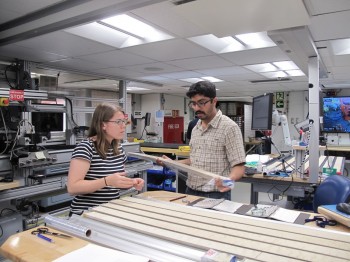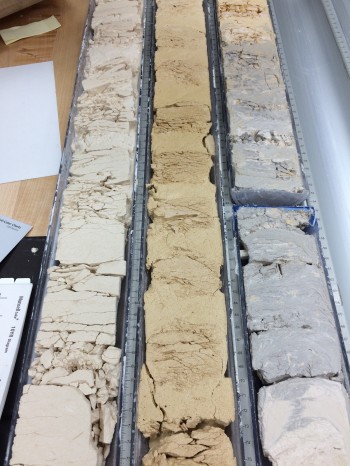A Sedimentologist at Sea in the Indian Ocean
November 2, 2015

In November of 2014, I embarked on a tremendous journey in my geoscientific career as I flew to Singapore to be a part of the International Ocean Discovery Program (IODP) Expedition 353. In Singapore I boarded the JOIDES Resolution, the IODP flagship, and began two months in the Indian Ocean drilling sediments in the Bay of Bengal.

The main goal of Expedition 353: Indian Monsoon Rainfall was to understand how the Indian monsoon evolved over the last several tens of millions of years. We did this by retrieving land-based sediments transported by rivers and wind to the Bay of Bengal, where they settled on the seafloor.
We use sediments to look deep into the past to learn about monsoons because we only have perhaps 100 years of instrumental measurements of rainfall over India — a geological instant.
I sailed as a sedimentologist. There were nine of us, and it was our job to document the cores using the SHIL and SHMSL: two imaging instruments that take high-resolution photographs, and make color-based and magnetic susceptibility measurements.
After these scans were finished, the fun began. Using tried and tested tools, we described the makeup of the mud. We documented the colors using Munsell charts, noted the texture of the sediments using the spatula, and examined interesting features using our hand-lens. We also documented how the drilling process might have disturbed the recovered cores, and made smear slides, where a small amount of sediment is placed on a glass slide for observation under a powerful microscope.
On Expedition 353, we drilled about 4.4 kilometers and described every meter in detail. These two months at sea helped solidify my love for climate and oceanic sciences. I learned a lot and had the opportunity to interact with experts from around the world. In October 2015, we will sample all the cores we collected, which are currently housed in Kochi, Japan. These sediments will form the basis of my scientific research for the coming few years and I am very eager to work with them.
— Kaustubh Thirumalai, Ph.D. candidate
Back to the Newsletter